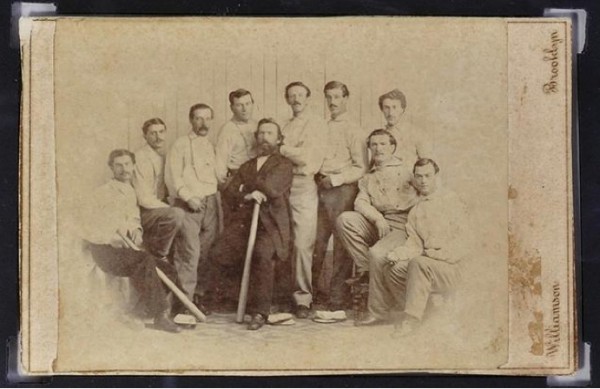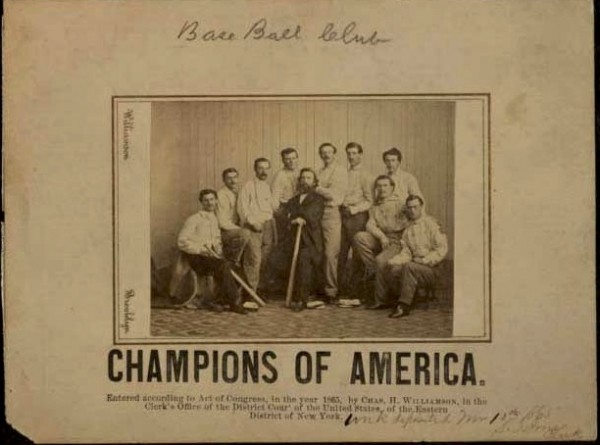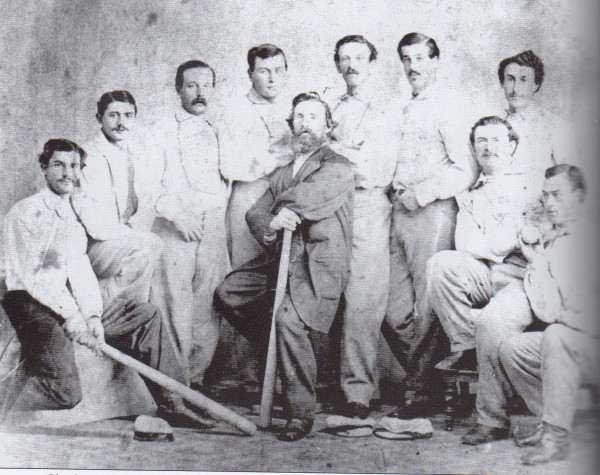Pitchers and catchers have reported for spring training. Baseball is in the air!
And, earlier this month, an 1865 photograph of a baseball team sold at auction in Biddeford, Maine, for a $92,000 ($80,000 was the top bid; with buyer’s premium, the total for the buyer to take it home was $92,000). Now, that was not just a photograph of any baseball team–it was the Brooklyn Atlantics.

Brooklyn was the center of early baseball in America. In The Book of American Pastimes (New York: 1866), Charles A. Peverelly (who is interred at Green-Wood) wrote: “The game of Base Ball has now become beyond question the leading feature of the out-door sports of the United States … It is a game which is peculiarly suited to the American temperament and disposition; the nine innings are played in the brief space of two and one half hours, or less. From the moment the first striker takes his position, and poises his bat, it has an excitement and vim about it … in short, the pastime suits the people, and the people suit the pastime.”
The Brooklyn Atlantics were baseball champions in 1861, 1864, and 1865. And they were a confident lot: they had the photographer Charles H. Williamson take the photograph that was sold at auction and mount it on card stock–as well as other copies that have disappeared–so that they could give them out to their opponents as souvenirs.
This “baseball card”–it actually predates the era of the baseball card, which began in the 1880s–was found in Baileyville, Maine, near the Canadian border, in an old photo album. The album, old Coca-Cola bottles, and two oak chairs were all purchased by the consignor of the card for less than $100.
What appears to be the same Williamson photograph of the Brooklyn Atlantics of 1865–though they are mounted differently on card stock– is at the Library of Congress.

And a slight variation on the auctioned photograph–with the players positioned the same as the other images, but having moved a bit–note, for instance, the player seated at far right: in the photograph below, he has his right arm bent so that the baseball he holds in his hand is up near his face; in the two images above, his hand holds the baseball down near his knee–is at the National Baseball Hall of Fame.

Here’s a television report on the auction from WCSH–Channel 6–in Portland Maine.
In the September 4, 1865 edition of the Brooklyn Daily Eagle, this letter appeared:
Dear Eagle:
I am beginning to take an interest in our national game. Which is baseball. Our noble city, third in population and first in Base Ball, has been glorified in field sports by the Atlantic Club, who have whipped everything in the ball line. As a Brooklynite, I am proud of the Atlantics. There are nine of them. They are wonderfully smart fellows. Stand six feet two in their stockings, can run two miles a minute, jump over a forty foot fence, or through a knot hole, turn a somersault and catch anything from a base ball to the measles. They are an honor to Brooklyn.
Many of the players who appear in this photograph are interred at Green-Wood. Fred Crane (standing at far right) was legendary for his smooth fielding: “the most graceful as well as sure and active fielder;” “[w]hen the ball is knocked in his neighborhood, off goes Fred’s cap, and he takes the ball in so easy a manner that fails not to draw applause.” Jack Chapman (seated, second from right) pioneered one-handed catches of fly balls. He was described as “a quick batsman, a long distance thrower, a sure catch and an effective slow pitcher.” Charles Smith (standing just to the right of club manager Peter O’Brien, who is wearing the dark jacket) was the Atlantic’s third baseman for a decade. He could do it all: another player called him “the greatest player of his time.” Sidney C. Smith (second from left) played right field for the Atlantics from 1864 through 1866–he then went on to work in the Kings County Tax Office.
And what of the photographer, Williamson of Brooklyn? Well, that would be Charles H. Williamson–who, as you might have guessed, is also interred at Green-Wood. Here is his obituary, published in the Photographer’s Friend upon his death in 1874:
IT is with regret that we announce the death of Mr. Charles H. Williamson, the well-known photographer of Brooklyn, which took place on Thursday, October 22d.
Mr. Williamson was one of the early daguerreotypers, and won an enviable distinction in his profession. He leaves a wife and two children. who have the warmest sympathy of the fraternity and a host of personal friends. We clip the following from the Brooklyn Union of Friday, October 23d:
“By the death of Charles H. Williamson the photographers of this city and, indeed, of the United States, have lost one of their most able associates in the profession. Mr. Williamson, after a somewhat severe illness of about ten days, passed away yesterday. The immediate cause of his death was congestion of the brain. Deceased learned the profession of photography at Springfield, Mass. Subsequently, in 1851, he came to Brooklyn, and opened a gallery adjoining the one he occupied at the time of his death. He was one of the earliest picture-takers in Brooklyn, when they were produced by what was then known as the daguerreotype system. Since then many improvements have been made in the art, and Mr. Williamson was not slow to take advantage of them. Ho was an excellent painter in water-colors, and many of the finest miniatures in his studio were finished by him. Several new styles of pictures originated with him, notably the cameo style. He introduced a system of teaching drawing from the transparent positive which has been found of great advantage to beginners in drawing. A few days before he was taken sick he was engaged on an invention for graying the background of pictures. He was an original member of the Brooklyn Photographic Art Association, and at its meetings read several papers on subjects relating to the profession. He was also a contributor to the Photographic Times, and other periodicals devoted to photography. One of the last pictures taken by deceased was ex-District Attorney Morris.
“Mr. Williamson was born in Scotland in 1826. The funeral took place the Sunday following his demise, from the Church of the Holy Trinity, and the services were conducted by Rev. Dr. Hall. Dr. Hall and Mr. Williamson were quite friendly, and it was by the invitation of the deceased that Dr. Hall became President of the Brooklyn Photographic Art Association.”
If you would like to learn more about early baseball and Green-Wood, you may purchase a copy of Peter Nash’s book, Baseball Legends of Brooklyn’s Green-Wood Cemetery, here.
And, if you would like to join me and baseball historian Tom Gilbert for “Opening Day in Brooklyn: Baseball Greats of Green-Wood,” a baseball trolley tour on Saturday, March 30, baseball’s opening day weekend, you will be able to purchase tickets online as soon as our spring calendar is up on our website–which should be very soon.